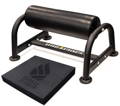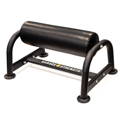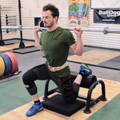How To Use A Single Leg Roller
The Single Leg Squat!!
At Garage Strength, the single-leg squat is an integral part of our training system. When it comes to preparing open-sport athletes (football players, soccer players, baseball players, field hockey players, lacrosse players, basketball players, and the list goes on and on), we program single-leg squats near every program. The movement is unrivaled in creating unilateral strength from the legs, hips, hamstrings, and quads. The single-leg squat is the king of the hill of unilateral leg movements.
The movement develops speed, power, and explosiveness. It also demands unparalleled balance, particularly when the weight on the barbell becomes hefty like a grocery bill.
Bulgarian Split Squat
First, let’s talk about how the single-leg squat is not Bulgarian. The terminology is based strictly around marketing in my opinion. Put a hard-nosed country in front of a movement and become a little bit cooler. I’m not buying it.
It’s the single-leg squat.
With all that said, there is a key piece of equipment that makes the single-leg squat such an unrivaled exercise. We have all tried to put our foot up on a bench press, a box, or some riser to simulate the position needed to adequately perform single-leg squats. None of the previously mentioned apparatuses work at the level elite performance demands. And that, my friend, is where the single-leg roller wins best in show and is awarded a blue ribbon for excellence.
Similar to the emphasis placed on bench press in training the upper body, the single-leg roller is as integral to the Garage Strength Parabolic Periodization method of training legs and core for sports performance athletes. This equipment piece is the hidden gem to cultivating as many champs, freaks, and all-around stud athletes as possible. For comfort, longevity, and safety, we also like to utilize a foam pad for the back knee to make contact with.
Let’s get into the most effective ways to use a single-leg roller for single-leg squats.

Targeting The Quads
For athletes trying to target their quads when doing single-leg squats, we want to place the front foot within 2-4” of the foam pad. Make sure the heel of the front foot stays grounded when the back knee is in contact with the pad. Balance is key. We want to drive that front foot into the ground, contract the quad, and explode out of the single-leg squat position.
If you want to target the quads further, raise the front heel on a slant board or plate. The raised heel allows for a greater range of motion through the ankle, putting the body in an advantageous position to strengthen and lengthen the quad muscle. We recommend starting on the slant board only using bodyweight and not moving onto loaded movements until the balance is legit AF.
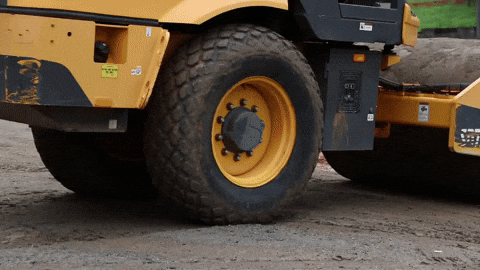
Quad targeting by performing single-leg squats with a single-leg roller is many. The movement and piece of equipment help develop the drive phase of sprinting, improve ankle mobility, and helps longer-limbed individuals feel their quads being targeted during the exercise. Single-leg squats performed while using a single-leg roller go a long way in developing athletic strength, especially when it comes to agility and running.
Targeting The Posterior Chain
We all know when it comes to the legs the posterior chain is primarily thought of as the hamstrings and glutes. Where that may not be completely right, it is close enough (and right enough) for the strength gains needed to increase speed, power, and accelerating/decelerating power through the use of a single-leg roller to perform single-leg squats.
Targeting the posterior chain, we want to place the front foot 10-14” in front of the foam pad. In doing this we want to make sure the hips are mobile enough and balance is controlled during the eccentric position of the lift. Moving out of control or off-balance is a surefire way to find yourself dumping the weights, being unsafe, and risking injury. Balance and control are a must.
That said, the benefits of performing the single-leg squat utilizing a single-leg roller are many for the posterior chain when the foot is placed 10-14” in front of the foam pad. The exercise can help pulling efficiency from the floor; meaning, single-leg squats can help strengthen the clean, snatch, and deadlift. In addition, the movement can improve the drive phase in sprinting due to the extra glute strength being developed. Finally, and probably most importantly, the movement transfers tremendously to sports performance.
How to Do A Single Leg Squat
The single-leg squat uses the erectors, glutes, hamstrings, and even the quads to a point. The movement sustains and helps dynamic trunk control which leads to a substantial transfer to competitive performance in sport.
To begin, we want to have about 70% of our weight on the front leg. The other 30% of our weight is in the back leg. We drive the back knee down and have the front knee track forward slightly. It is a very challenging movement. A lot of athletes will say it isn’t the weight. Well, actually, it is the weight if the athlete struggles with stability. As an athlete performs the movement more frequently and improves, their stability increases, their ability to produce strength and force from a unilateral position increases, and in turn leads to better speed and even better jumping ability.
Foot Position
The front foot position can be changed to target different aspects that correlate to speed and performance. For instance, putting the front foot tighter to the knee pad, we want to see the knee track well to target dorsiflexion in the ankle to help in the drive phase or coming out of the blocks. The closer foot position targets the quads slightly more. A longer stride position targets the hamstring–put the front foot about 8-10” in front of the pad.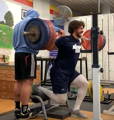
If coaches have athletes doing single-leg squats, have a roller. It is a piece of equipment to help the back leg get comfortable and be more stable to load the bar more. A word of advice, if the athlete's foot comes off the roller more than one time, we terminate the set.
Remember, the single-leg squat is a great movement to target the quads and functions as a cheat code to enhance how the posterior chain communicates. The exercise lights up the back so the erectors lead into the glutes which fire alongside the hamstrings as the hips are extended at the top. The movement improves the ability to accelerate and decelerate, which is key to cutting and agility.
Absolute Strength
I load the single-leg squat as an absolute strength movement when done with a barbell on the back. I will use the single-leg squat as an accessory movement with higher reps when done with a goblet weight, farmer’s carry hold, or a front rack to target any problem areas seen in various athletes.
As a rule of thumb, test for a three rep max on each leg. The three-rep single-leg max should be around 80% of an athlete’s max back squat.
Recap
If you are serious about being the most exceptional athlete you can be, you need to be doing single-leg squats on the regular. You need to be doing single-leg squats on the regular with equipment that not only provides the most safety, but also allows for the most intensity, and best groove of the movement, and, this may sound silly to all the too tough for their own good people out there, the most comfort. The single leg roller and foam pad are GREAT pieces of equipment for every and any athlete who wants to improve their sports performance.
Do you have a single-leg roller? And if not, why?
Related Posts
Blog Topics

Yo, It's Dane
Welcome to the Garage Strength Blog, where it is my goal to provide you with the experience and knowledge I've gained in the strength and conditioning world over many years of learning from both successes and failures. I train elite-level athletes in a multitude of sports from the high school to professional levels, already producing 5 Olympics and 30+ National Champions. If you want to be the next champion I train, check out my strength programs below!
Start Training With Me

Join for free educational videos EVERY WEEK on strength coaching and athletic performance

